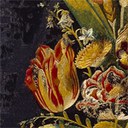0130 Philipp van den Bossche – Sac. Caes. Mai. Phrygiarius
Identifiers (Article)
Identifiers (Files)
Abstract
The text summs up the knowledge on the personality of Philipp van den Bossche who worked at the Prague court of Rudolph II as a silk-embroider. Heinrich Modern opened a fresh view on this artist by two articles dealing with his activities as an outstanding landscape drawer whose work can be seen in the context of the Prague court and in close relationship with the drawings of Paul van Vianen, Pieter Stevens, or Roelandt Savery. The inventory of the Kunstkammer of Rudolph II from the years 1607–1611 lists interesting entries documenting Bossche's embroideries with the motives of landscapes, figural scenes, and still lives. The main part of the text concentrates on the relationship of these embroideries with two embroidered still lives with flower vases from the collections of Det danske Kunstindustrimuseum in Copenhagen.
Statistics


License

This work is licensed under a Creative Commons Attribution-NonCommercial-NoDerivatives 4.0 International License.



